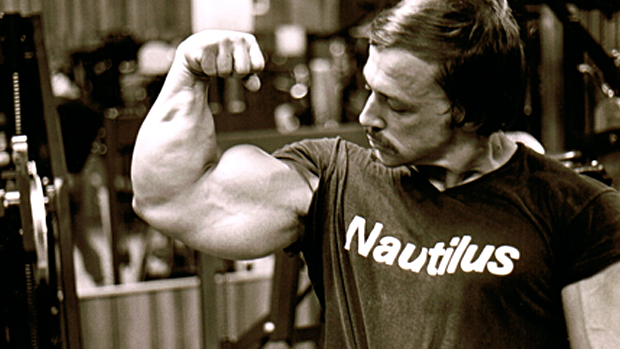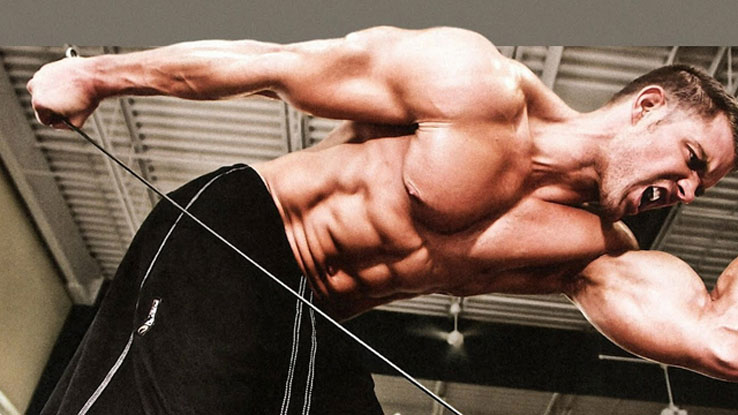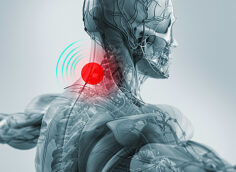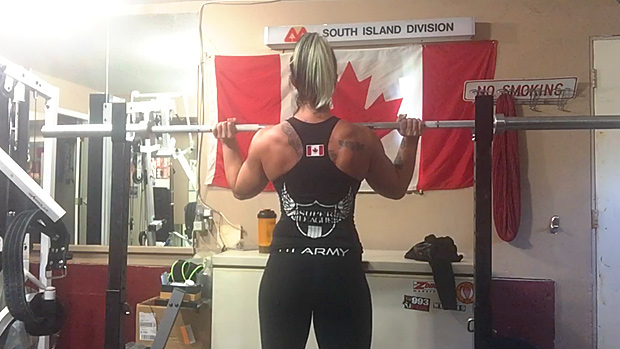Need a routine that's more than just different? Something that bloodies
your lip, demolishes your plateau, and jolts your muscles to grow? Then pay
attention to Big Jim Flanagan.
 |
Welcome to Jim Flanagan's House of Pain. Get ready for a workout you'll
never forget.
"I'm so sore I can barely sit down," Travis Hillpot said, uncomfortably
adjusting his position in his chair. "It's amazing, I can already feel my
lower body growing."
It was February 3, 2008, and I'd just joined Jim Flanagan and Travis
at Starbucks in Longwood, Florida. Interestingly, I'd met with Jim and
Travis approximately a year earlier, learned about Jim's special routine,
and my write-up about it on my website was
one of my most popular articles for 2007.
So this meeting was like deja vu.
The day before, Jim had trained Travis in his private gym, which features,
among other equipment, six first-generation Nautilus machines. This collection
of Nautilus machines is one of his holdovers from the 1970s. Both Jim and
I feel that the training principles that Arthur Jones introduced to the bodybuilding
world in the 1970s are not only worth remembering, but still produce outstanding
results with subjects who want to build muscle fast.
"Travis had missed a couple of workouts and he was a little stale. He needed
something different to kick-start him back into a growth cycle. That's why
I administered one of my special surge routines," Jim said as he looked
at me with a slight smile and a big wink.
I immediately knew where Jim was coming from. He and I had devised many
unusual, kick-ass routines when we trained Casey Viator for the 1978 Mr.
Universe contest.
Meet Jim Flanagan
Those who are familiar with my latest book, The New Bodybuilding for
Old-School Results, will recognize Jim Flanagan from page 112. Jim
and I met Arthur Jones about the same time, and we both trained in 1971
under Jones's supervision at the DeLand High School Quonset hut in Florida.
We both ended up working with Jones for the next two decades.
Presently, Jim only trains a few, hard-nosed men once a week at his one-of-a-kind
gym, his latest victim being Travis Hillpot.
 |
Big Jim's private gym, walls adorned with over 250 autographed photos
of well-known athletes.
Jim went to high school in Kissimmee, Florida (near Orlando), and graduated
from the University of Central Florida. He was inspired to start lifting
in 1968 by the legendary strongman/wrestler, Milo Steinborn. At the time,
Jim was 6' 5" tall and weighed only 185 pounds. He responded to Milo's coaching,
which involved basic barbell exercises, including heavy sessions of full
squats.
 |
Henry "Milo" Steinborn, the original "Dr. Squat."
"During the first 12 months of Milo's tutelage," Jim remembered,
"I packed on 50 pounds of muscle, and I was still on the thin side."
As you might have guessed, Jim Flanagan is thin no more. He
weighs a solid 285 pounds, and at 61 years of age, he still looks as if he
could turn over a pickup truck with either hand, then devour a 5-pound roast
with all the trimmings.
 |
Big Jim's post-pickup truck-flipping workout meal.
For now, however, let's get back to his plateau-busting surge routine
that he's personally applied with some of his trainees.
"Jim," I said, "why don't you tell me more about your unique, growth-producing
routine? In fact, since I have my camera in the car, why don't we drive over
to your gym so I can photograph what you guys performed, exercise by exercise?"
The Plateau-Busting Surge Routine
"There are 8 exercises in the workout," Jim said as we were driving over
to his home. "But the thing that separates it from other routines is what
I had Travis do during exercises 1-6.
"For these exercises, Travis did an all-out, 1-rep maximum on the positive
lifting. From his previous workouts and my overall experience, I had a good
idea what he could do one time, even though we normally don't train that
way. That maximum positive was immediately followed by a very slow negative."
"What was the count on the negative?" I asked.
"Our goal was a maximum of 60 seconds, which Travis achieved on half of
the exercises." Jim replied. "It was an eye-opening start."
"Start? You mean there was more?" I wanted to know.
"Yep," Jim replied. "When Travis finished that very slow negative, I quickly
reduced the resistance on each machine by 50 percent and he did as many reps
as he could, which usually was in the neighborhood of 6 to 8, each one in
good form (a 3-second positive and a 3-second negative)."
I grabbed a pencil as Jim talked, and I listed the following six exercises:
Leg press machine
Pullover machine
Pulldown machine
Decline press machine
Lateral raise machine
Biceps curl machine
Again, each of the above exercises is a 1-rep maximum (use as much weight
as you can in good form) and then you try to lower that same resistance in
an agonizingly slow 60 seconds.
"That max positive and 60-second negative," Jim noted, "make a beyond-normal
inroad into your starting strength level."
"You're right about that," I said. "Add another 6 to 8 reps with less resistance
to that and you've got a 50-percent inroad, which is very significant. No
wonder Travis is having such a hard time moving around today. It will probably
take him another three or four days to recover fully."
"It's that unexpected difference," Jim noted, "plus, that unusually deep
inroad, which surge the body with growth-inducing chemicals. Whatever
sticking point you may be experiencing is quickly eradicated and, in a matter
of a few days, from one workout, you become bigger and stronger. I've
seen it happen again and again with the men I expose to this cycle."
The Other 2 Exercises
"Jim, what about the seventh and eighth exercises?" I asked.
"What did Travis do?"
"The last two," Jim answered, "are finishers, and they can vary. During
Travis's workout, he did pushups on the floor, performed in a slow 10-second
up/10-second down style, then seated dips on a machine in a normal manner.
My goal with those two was to pump and finish his triceps, which we did.
"But in similar routines, I've used such exercises as the wrist curl, reverse
wrist curl, grippers, neck machines, and abdominal movements. Any two of
them will work well.
"Or, depending on the trainee and his strength level, we might not do
exercises 7 and 8. With a lot of strong, advanced athletes, the final two
exercises aren't necessary."
After the 10-minute drive, we were at Big Jim's private gym.
"Okay guys," I said, "let's give the interested readers a few pictures of
some of the recommended exercises." Travis looked like a whipped dog as he
climbed into Jim's leg press machine.
"Come on Travis," I said in an upbeat manner, "repeating today what you
did yesterday is the best way to eliminate some of that pain."
Travis smiled. He knew what I was saying was true, and he also knew all
I wanted was a few demonstration-type pictures, not actual shots taken during
his workout.
 |
"I really like the MedX Avenger Leg Press/Squat machine," Jim says. "The
machine has almost no internal friction and the resistance curve is right
where it should be."
 |
Travis prepares for the seated biceps curl machine.
At 32 years of age, Travis is 6' 1" and weighs 225 pounds.
Tips on Getting the Best Results
Over the last year, I've had a chance to go through all the listed exercises
while applying the recommended techniques. Here are the guidelines to prepare
your body for quality stimulation:
Do at least one warm-up set with less resistance before each of your 1-repetition
maximums. Most trainees can do 1 rep with approximately 20-percent more resistance
than they can do normally for 8 to 10 reps to muscular failure.
Find a training partner to keep track of the time (total seconds) on the
negatives. You'll probably need some "tough talk"
to get you through each movement. At the very least, you need to stay with
it for 30 seconds on the recommended machines. With barbells, you'll have
to make some adjustments.
Barbell Adjustments
• Unlike most machines, barbell exercises have
very peaked resistance curves that won't allow extremely slow action. As
a result, you'll need to quicken the lowering and do several repetitions.
• Have a spotter on either side as you perform
the free-weight movements, such as the squat, deadlift, bench press, and
curl.
• After your one-rep maximum, instead of one 60-second
lowering, try three 10 to 15 second negatives, which will still be very challenging with
a barbell. The spotters must carefully and quickly do the positive lifting
as you achieve the three consecutive lowering reps.
• Don't hold your breath during the lifting and
lowering. Keep your mouth open and practice breathing out more than breathing
in.
• After the slow negative(s), have your training
buddy quickly reduce the resistance on the machine or barbell by 50 percent
and continue until it's impossible to perform another positive movement.
• It's not necessary to rush between exercises.
Take approximately 2 minutes to move from one exercise to the next.
• Can you continue this routine for two or three
consecutive workouts? No! Such combined techniques should not be performed
more than once a
month.
• Rest completely (and I mean completely!) for at least
4 days before you train again on your normal routine.
IMPORTANT: This plateau-busting workout combines best with heavy-duty, strength-training
machines. Please note the adjustments that must be made in using barbells.
Below is a suggested barbell routine:
Squat
Bent-over row
Bench press
Biceps curl
Stiff-legged deadlift
Shoulder shrug
Solid Muscular Growth
"You'd better be in descent shape to tackle the super-taxing routine, "Big
Jim said. "It's definitely not for beginners."
"If you can withstand the ensuing pain, endure the overall shock, and take
it easy for four days, you'll be rewarded with a surge of solid muscular
growth."
 |
Jim completes a set on one of the first Nautilus pullover machines (plateloading).
Thanks, Jim, for your creative techniques and your old-school dedication.
For information on high-quality strength-training equipment, visit Big Jim
at his website.





